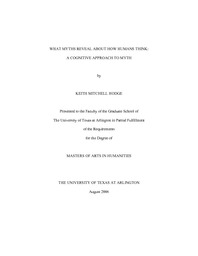| dc.description.abstract | This thesis has two main goals: (1) to argue that myths are natural products of human cognition; and (2) that structuralism, as introduced by Claude Levi-Strauss, provides an over-arching theory of myth when supplemented and supported by current research in philosophy of mind, cognitive psychology, and cognitive anthropology. With regard to (1), we argue that myths are naturally produced by the human mind through individuals' interaction with their natural and social environments. This interaction is constrained by both the type of body the individual has and the environment in which the individual is situated. From this interaction, we argue, is produced the human-body metaphor which plays an essential role in forming analogical mental models which humans use to navigate, predict, and think about their environment(s). With regard to (2), we argue that these analogical mental models are the structures from which myths are created, just as structural anthropology suggests. | en_US |

